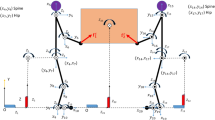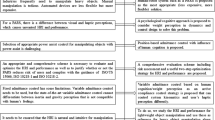Abstract
This paper presents a human–robot collaborative symmetric lifting motion prediction using inverse dynamics optimization. The human and robot arm are modeled in Denavit-Hartenberg (DH) representation. A floating-base rigid body with 6 global degrees of freedom (DOFs) is similarly modeled as a three-dimensional (3D) table. A set of grasping forces characterizes the human-table and robot-table interactions. The joint torque squares of human arm and robot arm are minimized and subjected to physical and task related constraints. During lifting, the design variables include the cubic B-spline control points of joint angle profiles of the human arm, robot arm, and table. In addition, the discretized grasping forces are also treated as design variables. Both numeric and experimental human–robot lifting was performed with a 2 kg table. The simulation reports the human and robot arm’s joint angle profiles, joint torque profiles, and grasping force profiles. These profiles were validated with experimental data, which was collected using a motion capture system, force sensors, and the robot operating system (ROS). The human and robot arms’ joint angle and torque profiles demonstrate a similar trend in the experimental environment. The grasping force comparison implies that the human and robot share the load while lifting together.
Similar content being viewed by others
Data Availability
No.
Code Availability
No.
References
Bauer, A., Wollherr, D., Buss, M.: Human–robot collaboration: a survey. Int. J. Humanoid Rob. 5(01), 47–66 (2008)
Rozo, L., Calinon, S., Caldwell, D.G., Jimenez, P., Torras, C.: Learning physical collaborative robot behaviors from human demonstrations. IEEE Trans. Rob. 32(3), 513–527 (2016)
Xiang, Y., Arora, J.S., Rahmatalla, S., Marler, T., Bhatt, R., Abdel-Malek, K.: Human lifting simulation using a multi-objective optimization approach. Multibody Sys.Dyn. 23(4), 431–451 (2010)
Xiang, Y., Arora, J.S., Abdel-Malek, K.: 3D human lifting motion prediction with different performance measures. Int. J. Humanoid Rob. 9(02), 1250012 (2012)
Song, J., Qu, X., Chen, C.H.: Simulation of lifting motions using a novel multi-objective optimization approach. Int. J. Ind. Ergon. 53, 37–47 (2016)
Xiang, Y., Arefeen, A.: Two-dimensional team lifting prediction with floating-base box dynamics and grasping force coupling. Multibody Sys.Dyn. 50, 211–231 (2020)
Wang, Q., Xiang, Y., Kim, H.J., Arora, J.S., Abdel-Malek, K.: Alternative formulations for optimization-based digital human motion prediction. Proceedings of 2005 Digital Human Modeling for Design and Engineering Symposium, June 14–16, Iowa City, IA, SAE Technical Paper 2005–01–2691. (2005)
Evrard, P., Gribovskaya, E., Calinon, S., Billard, A., and Kheddar, A.: Teaching physical collaborative tasks: object-lifting case study with a humanoid. 2009 9th IEEE-RAS International Conference on Humanoid Robots, December 7–10, Paris, France, pp. 399–404. (2009)
Evrard, P., Kheddar, A.: Homotopy switching model for dyad haptic interaction in physical collaborative tasks. In World Haptics Third Joint EuroHaptics Conference and Symposium on Haptic Interfaces for Virtual Environment and Teleoperator Systems (pp. 45-50). IEEE, Salt Lake City, UT, USA (2009)
DelPreto, J., Rus, D.: Sharing the load: human-robot team lifting using muscle activity, in 2019 IEEE International Conference on Robotics and Automation (ICRA), May 20–24, Montreal, Canada. (2019)
Calinon, S., Evrard, P., Gribovskaya, E., Billard, A. and Kheddar, A.: Learning collaborative manipulation tasks by demonstration using a haptic interface. In: 2009 International Conference on Advanced Robotics, pp.1–6, June 22–26, Munich, Germany. (2009)
Agravante, D.J., Cherubini, A., Bussy, A., Gergondet, P., Kheddar, A.: Collaborative human-humanoid carrying using vision and haptic sensing. In 2014 IEEE International Conference on Robotics and Automation (ICRA) (pp. 607–612). IEEE, Hong Kong, China (2014)
Lawitzky, M., Medina, J.R., Lee, D., Hirche, S.: Feedback motion planning and learning from demonstration in physical robotic assistance: differences and synergies. In 2012 IEEE/RSJ International Conference on Intelligent Robots and Systems (pp. 3646–3652). IEEE, Vilamoura-Algarve, Portugal (2012)
Sheng, W., Thobbi, A., Gu, Y.: An integrated framework for human–robot collaborative manipulation. IEEE Trans. Cybern. 45(10), 2030–2041 (2014)
Rozo, L., Calinon, S., Caldwell, D., Jiménez, P., Torras, C.: Learning collaborative impedance-based robot behaviors. In Proceedings of the AAAI Conference on Artificial Intelligence (Vol. 27, No. 1, pp. 1422–1428). Bellevue, Washington USA (2013)
Rozo, L., Bruno, D., Calinon, S. and Caldwell, D.G.: Learning optimal controllers in human-robot cooperative transportation tasks with position and force constraints. In 2015 IEEE/RSJ International Conference on Intelligent Robots and Systems (IROS) (pp. 1024–1030). September 28-October 2, Hamburg, Germany. IEEE. (2015)
Wang, Z., Peer, A. and Buss, M.: An HMM approach to realistic haptic human-robot interaction. In World Haptics 2009-Third Joint EuroHaptics Conference and Symposium on Haptic Interfaces for Virtual Environment and Teleoperator Systems (pp. 374–379). March 18–20, Salt Lake City, UT, USA. IEEE. (2009)
Mörtl, A., Lawitzky, M., Kucukyilmaz, A., Sezgin, M., Basdogan, C., Hirche, S.: The role of roles: Physical cooperation between humans and robots. The Int. J. Robot. Res. 31(13), 1656–1674 (2012)
Bussy, A., Gergondet, P., Kheddar, A., Keith, F., Crosnier, A.: Proactive behavior of a humanoid robot in a haptic transportation task with a human partner. In 2012 IEEE RO-MAN: The 21st IEEE International Symposium on Robot and Human Interactive Communication (pp. 962–967). IEEE, Paris, France (2012)
Li, Y., Ge, S.S.: Human–robot collaboration based on motion intention estimation. IEEE/ASME Trans. Mechatron. 19(3), 1007–1014 (2013)
Passenberg, C., Groten, R., Peer, A., Buss, M.: Towards real-time haptic assistance adaptation optimizing task performance and human effort. In 2011 IEEE World Haptics Conference (pp. 155–160). IEEE, Istanbul, Turkey (2011)
Peternel, L., Kim, W., Babič, J., Ajoudani, A.: Towards ergonomic control of human-robot co-manipulation and handover. In 2017 IEEE-RAS 17th International Conference on Humanoid Robotics (Humanoids) (pp. 55–60) November 15–17. IEEE, Birmingham, UK (2017)
van der Spaa, L., Gienger, M., Bates, T. and Kober, J.: Predicting and optimizing ergonomics in physical human-robot cooperation tasks. In 2020 IEEE International Conference on Robotics and Automation (ICRA) (pp. 1799–1805). May 31-August 31, virtual conference. IEEE. (2020)
Arefeen, A., Xiang, Y.: Design human-robot collaborative lifting task using optimization. Proceedings of the ASME 2021 International Design Engineering Technical Conferences and Computers and Information in Engineering Conference. Volume 2: 41st Computers and Information in Engineering Conference (CIE). August 17–19, 2021, Online, V002T02A010. (2021)
Wojtara, T., Uchihara, M., Murayama, H., Shimoda, S., Sakai, S., Fujimoto, H., Kimura, H.: Human–robot collaboration in precise positioning of a three-dimensional object. Automatica 45(2), 333–342 (2009)
Maurice, P., Huber, M.E., Hogan, N., Sternad, D.: Velocity-curvature patterns limit human–robot physical interaction. IEEE Robot. Autom. Lett. 3(1), 249–256 (2017)
Parker, C.A., Croft, E.A.: Experimental investigation of human-robot cooperative carrying. In 2011 IEEE/RSJ International Conference on Intelligent Robots and Systems (pp. 3361–3366). September 25–30. IEEE, San Francisco, CA, USA (2011)
Gill, P.E., Murray, W., Saunders, M.A.: SNOPT: An SQP algorithm for large-scale constrained optimization. SIAM J. Optim. 12(4), 979–1006 (2002)
Lorenzini, M., Kim, W., De Momi, E., Ajoudani, A.: A synergistic approach to the real-time estimation of the feet ground reaction forces and centers of pressure in humans with application to human–robot collaboration. IEEE Robot. Autom. Lett. 3(4), 3654–3661 (2018)
Roveda, L., Haghshenas, S., Caimmi, M., Pedrocchi, N., Molinari Tosatti, L.: Assisting operators in heavy industrial tasks: On the design of an optimized cooperative impedance fuzzy-controller with embedded safety rules. Front. Robot. AI 6, 75 (2019)
Kim, W., Lee, J., Peternel, L., Tsagarakis, N., Ajoudani, A.: Anticipatory robot assistance for the prevention of human static joint overloading in human–robot collaboration. IEEE Robot. Autom. Lett. 3(1), 68–75 (2017)
Sartore, C., Rapetti, L., Pucci, D.: Optimization of humanoid robot designs for human-robot ergonomic payload lifting. In 2022 IEEE-RAS 21st International Conference on Humanoid Robots (Humanoids) (pp. 722–729). November 28–30. IEEE, Ginowan, Japan (2022)
Al-Yacoub, A., Zhao, Y.C., Eaton, W., Goh, Y.M., Lohse, N.: Improving human robot collaboration through Force/Torque based learning for object manipulation. Robot. Comput. Integr. Manuf. 69, 102111 (2021)
Arefeen, A., Xiang, Y.: Modeling and simulation of a powered exoskeleton system to aid human-robot collaborative lifting. In Proceedings of the 7th International Digital Human Modeling Symposium (DHM 2022) and Iowa Virtual Human Summit 2022 (Vol. 7, No. 1), August 29–31, Iowa city, IA, USA. (2022)
Denavit, J., Hartenberg, R.S.: A kinematic notation for lower-pair mechanisms based on matrices. J. Appl. Mech. 22, 215–221 (1955)
Cheng, H., Obergefell, L., and Rizer, A.: Generator of body (GEBOD) manual, AL/CF-TR-1, Dayton, OH, USA. (1994)
Wang Y., Kong X., Yang J., Zhao G.: Motion performance analysis of the sawyer ankle rehabilitation robot. In: Tan J. (eds) Advances in Mechanical Design. ICMD 2019. Mechanisms and Machine Science, vol 77. Springer, Singapore.994–0051, Armstrong Laboratory, Wright-Patterson Air Force Base, Ohio. (2020)
Xiang, Y., Arora, J.S., Rahmatalla, S., Abdel-Malek, K.: Optimization-based dynamic human walking prediction: one step formulation. Int. J. Numer. Meth. Eng. 79(6), 667–695 (2009)
Rethink robotics, 2022, Arm control system. Retrieved on February 10, 2022 from https://support.rethinkrobotics.com/support/solutions/articles/80000980284-arm-control-system#Joint-Control-Modes
Arefeen, A., Xiang, Y.: Two-dimensional team lifting prediction with different box weights. Proceedings of the ASME 2020 International Design Engineering Technical Conferences and Computers and Information in Engineering Conference. Volume 9: 40th Computers and Information in Engineering Conference (CIE). August 17–19, 2020, Online, V009T09A004. (2020)
Xiang, Y., Zaman, R., Rakshit, R., Yang, J.: Subject-specific strength percentile determination for two-dimensional symmetric lifting considering dynamic joint strength. Multibody Sys.Dyn. 46(1), 63–76 (2019)
Xiang, Y., Cruz, J., Zaman, R., Yang, J.: Multi-objective optimization for two-dimensional maximum weight lifting prediction considering dynamic strength. Eng. Optim. 53(2), 206–220 (2021)
Acknowledgements
This study is partially supported by Grant No. T42OH008421 from the National Institute for Occupational Safety & Health (NIOSH) to the Southwest Center for Occupational and Environmental Health (SWCOEH), National Science Foundation project 1849279 and 2014281, and Research Jumpstart/Accelerator Grant from Oklahoma State University. We thank anonymous reviewers for providing us the valuable suggestions to improve the presentation of the material in this study.
Funding
This work was supported by Grant No. T42OH008421 from the National Institute for Occupational Safety & Health (NIOSH/CDC) to the Southwest Center for Occupational and Environmental Health (SWCOEH), National Science Foundation project CBET 1849279 and 2014281, and Research Jumpstart/Accelerator Grant from Oklahoma State University. All these grants are funded to Y.X.
Author information
Authors and Affiliations
Contributions
Conceptualization, Y.X.; methodology, A.A. and Y.X.; validation, A.A., J.Q. and S.S.; formal analysis, A.A., J.Q. and S.S.; data curation, A.A., J.Q. and S.S.; writing—original draft preparation, A.A., J.Q., and Y.X.; writing—review and editing, Y.X. and H.B.; supervision, Y.X. and H.B.; project administration, Y.X.; funding acquisition, Y.X. All authors have read and agreed to the published version of the manuscript.
Corresponding author
Ethics declarations
Ethics Approval
The human subject experiment was approved by Institutional Review Board at Oklahoma State University. The IRB number is IRB-21–501.
Consent to Participate
Informed consent was obtained from all individual participants included in the study.
Consent for Publication
The authors affirm that human research participants provided informed consent for publication of the images in Figure(s) 3 and 12.
Conflicts of Interest
The authors declare they have no financial interests.
Additional information
Publisher's Note
Springer Nature remains neutral with regard to jurisdictional claims in published maps and institutional affiliations.
Rights and permissions
Springer Nature or its licensor (e.g. a society or other partner) holds exclusive rights to this article under a publishing agreement with the author(s) or other rightsholder(s); author self-archiving of the accepted manuscript version of this article is solely governed by the terms of such publishing agreement and applicable law.
About this article
Cite this article
Arefeen, A., Quarnstrom, J., Syed, S.P.Q. et al. Human–Robot Collaborative Lifting Motion Prediction and Experimental Validation. J Intell Robot Syst 109, 80 (2023). https://doi.org/10.1007/s10846-023-02013-y
Received:
Accepted:
Published:
DOI: https://doi.org/10.1007/s10846-023-02013-y




